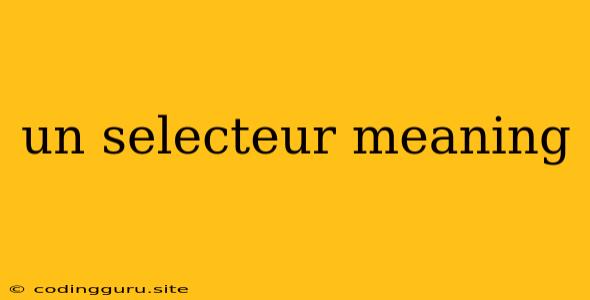What is a "Selecteur" and Why Does It Matter?
In the world of web development, particularly in the realm of CSS, the term "selecteur" (pronounced "se-lec-teur" in French) is frequently encountered. While often translated directly as "selector" in English, understanding the true meaning of "selecteur" requires delving deeper into its function and purpose within CSS.
The Heart of CSS: Selecting and Styling
At its core, CSS (Cascading Style Sheets) is a language that dictates how web pages are presented visually. It governs elements like colors, fonts, sizes, and positioning, transforming raw HTML into an engaging and aesthetically pleasing experience for users.
Selecteurs are the crucial instruments that enable this control. They act as addressing systems within the HTML document, identifying specific elements to which CSS rules will be applied.
Think of it as sending a letter: the address on the envelope determines the specific recipient. Similarly, selecteurs pinpoint specific elements in your HTML structure, allowing you to target them with your styling rules.
Unveiling the Variety: Types of Selecteurs
Selecteurs come in various flavors, each tailored for specific needs:
1. Element Selectors: The most basic type targets elements by their HTML tag names. For instance:
p {
color: blue;
}
This rule applies the color blue to all paragraph elements (<p>) on the page.
2. Class Selectors: These are used to apply styles to elements sharing a common class attribute. For example:
This text is highlighted.
.highlight {
background-color: yellow;
}
The class "highlight" is applied to the <div>, and the associated CSS rule sets the background color to yellow.
3. ID Selectors: Used for unique identification, ID selectors target elements with specific IDs.
Welcome to our Website
#main-heading {
font-size: 3em;
text-align: center;
}
The heading with the ID "main-heading" receives the specified font size and alignment.
4. Attribute Selectors: These target elements based on their attributes, such as their "href" value for links or "alt" text for images.
Visit Example
a[href="https://www.example.com"] {
color: red;
}
This rule applies red color to links pointing to "https://www.example.com".
5. Pseudo-classes: These allow styling of elements based on their state or specific conditions.
Link
a:hover {
text-decoration: underline;
}
The underlined style is applied to the link (<a>) only when the mouse hovers over it.
6. Pseudo-elements: These target specific parts of an element, not the element itself.
p::first-letter {
font-size: 2em;
}
This rule styles the first letter of every paragraph element (<p>) with a larger font size.
The Power of Selecteurs: Specificity and Inheritance
Specificity: This is a key concept when working with selecteurs. It defines the priority of different rules when multiple rules target the same element. More specific rules, like those using IDs or multiple classes, override less specific rules.
Inheritance: CSS rules can also be inherited from parent elements to their children. For example, if a paragraph is nested within a <div> with a specific font family, that font family will be inherited by the paragraph unless overridden by a more specific rule.
Mastering Selecteurs: Towards Effective Styling
Understanding Selecteurs is fundamental to creating well-structured and visually appealing web pages. By carefully selecting your elements, you can precisely control their appearance and behavior, achieving the desired look and feel for your website.
Here are some practical tips for leveraging Selecteurs:
- Keep it Simple: Start with basic selecteurs and gradually increase complexity as needed.
- Be Specific: Avoid over-generalization. Target specific elements with IDs or classes for more precise control.
- Use Comments: Add comments to your CSS code to clarify your selecteur intentions and make your code more understandable.
- Utilize Tools: Browser developer tools and CSS validators can assist in identifying potential issues with your selecteurs.
Conclusion
Selecteurs, the essential building blocks of CSS, provide the means to manipulate and style HTML elements, defining the visual presentation of web pages. Mastering them is crucial for creating engaging and aesthetically pleasing web experiences.
